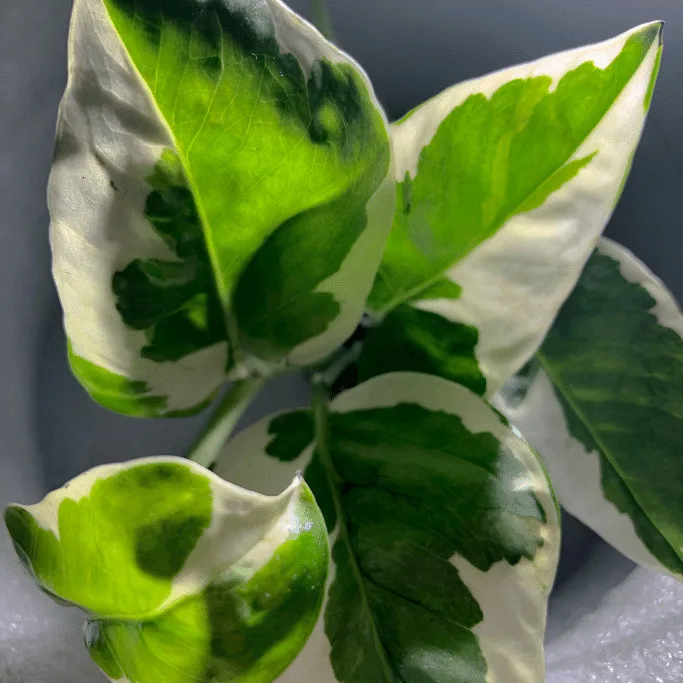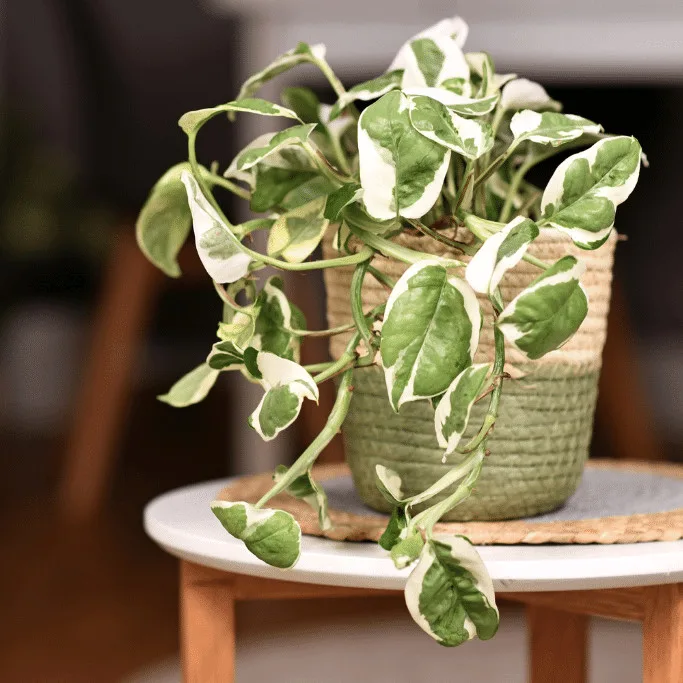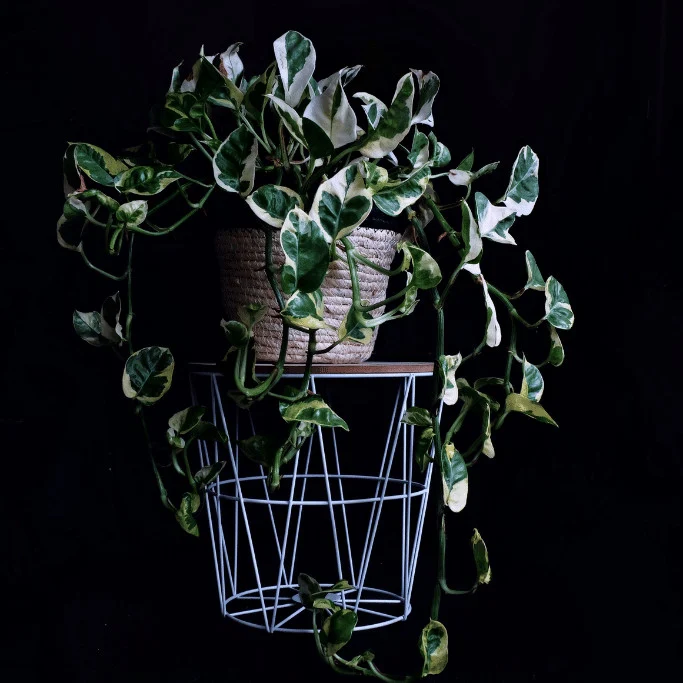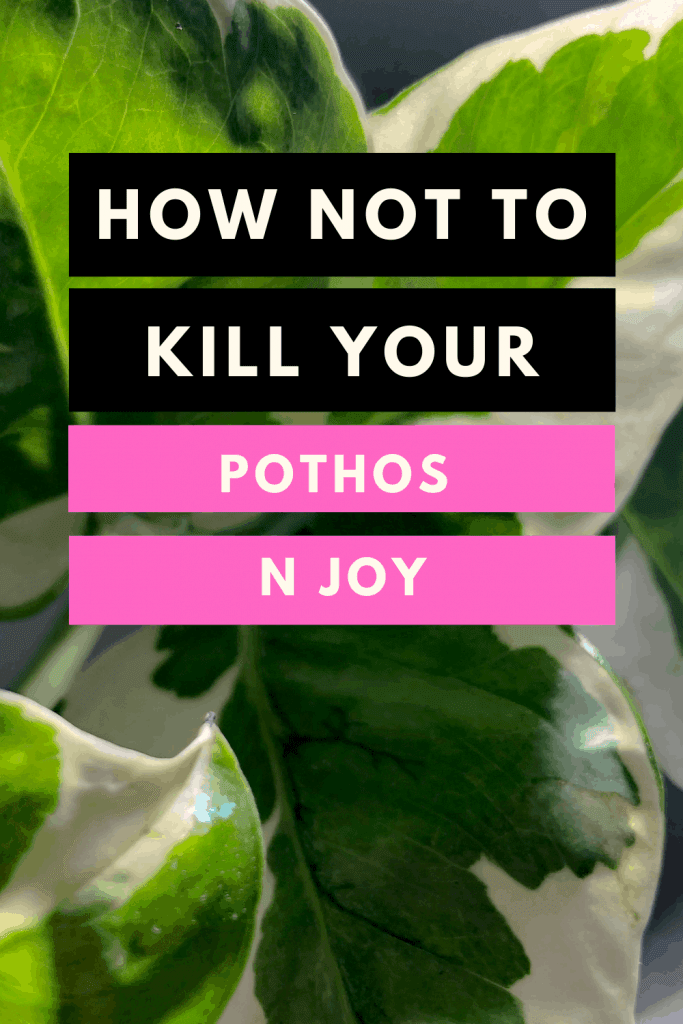The NJoy Pothos was among the first houseplants that I started with.
It is a cultivar of the Marble Queen Pothos.
If you’re looking to care for the NJoy Pothos, here is a detailed guide on caring for the Pothos N-joy.
Pothos or Epipremnum aureum is a genus of many different Pothos varieties such as the Manjula Pothos and the Snow Queen Pothos stemming from the Araceae family according to the University of Florida.
Pothos are easy to care for and are quite forgiving.
NJoy Pothos Care
To care for NJoy Pothos provide it with a potting mix consisting of 1/2 peat and 1/2 perlite. Provide bright to moderate indirect light. Water once the top 1” almost dry out about once a week. Keep the temperature between 65 to 85°F (18°C to 29°C). Humidity between 50-70% is ideal. Fertilize once a month in spring and summer with an NPK fertilizer of 10-10-10 or 5-5-5. Reduce to once a month during the other seasons.

NJoy Pothos Care
Table of Contents
NJoy Pothos Care Guide
Soil
Pothos NJoy grows best in a well-draining potting mix consisting of 50% perlite and 50% peat.
One thing I like about N-joy is that it’s not choosy about the potting mix it’s planted in.
You can grow it in any soil as long as it has good drainage.
This is a substrate that is completely free of all living organisms.
I use a potting mixture made of peat moss. I like it because it’s able to retain moisture and nutrients long enough to be absorbed by the roots.
Light
Bright to moderate indirect light is best for growing Pothos NJoy.
The Pothos N-joy can grow in different lighting conditions, including low light.
Even if it can tolerate low light, this will come at a cost as it will likely lose its variegation.
How can you tell whether your Pothos n joy is receiving adequate light? Well, the most common sign is that the leaves will turn greener.
By turning greener, they can harness as much of the little light as possible.
This way, they’re still able to make food and energy for the plant. To reverse this condition, simply relocate your plant to an area with more lighting.
On the other end of the spectrum, your plant could be receiving too much light. If this happens, its leaves will turn pale yellow or white.
To reverse this condition, all you need to do is move your plant to a more shaded area.
Now, whether you grow your N-joy indoors or outdoors, what’s important is that you shield it from direct sunlight. If exposed to direct sunlight, the UV rays will scorch its leaves.
Watering
The Pothos N-joy grows best in slightly moist soil. Water it once the top 1” (2.5 cm) almost dry out.
That said, you should be careful not to overwater it. Despite being one of the hardiest houseplants, N-joy is still susceptible to “wet feet”.
This condition is caused by two main things: poor drainage and overwatering.
To prevent this, you’ll want the top one and a half to two inches of soil to dry out before watering.
As with light, the most common indicator that you’re over or under watering your plant is the leaves’ condition.
Interestingly, they behave the same way in both cases. That is, they turn brown and wilt both when you over- or under water the plant.
How then, can you tell the difference between overwatering and underwatering? Simple. Place your index finger at least one inch below the soil’s surface.
If it’s moist, it means you are overwatering. But if it’s dry, it means you are underwatering it.

NJoy Pothos trailing out of a pot
Temperature
Pothos N-joy thrives in temperatures ranging from 65 to 85°F (18°C to 29°C).
Just be sure to maintain room temperature in the area where you’re keeping this plant. This means placing it away from appliances such as your heating and air conditioning units.
Humidity
Humidity between 50-70% is bet to grow NJoy Pothos.
This plant doesn’t mind low humidity levels. However, it hails from a tropical climate, meaning it fares better in a humid environment.
For optimal growth, maintain humidity in the 50 to 70% range.
Fertilizer
Apply a well-balanced fertilizer of NPK 10-10-10 or 5-5-5 dilute to half-strength every two weeks in the growing season (spring and summer).
Reduce fertilization to once a month in autumn and winter.
Feed your plant either monthly or bi-monthly to boost its growth. Also, ensure that the fertilizer you use is intended for houseplants.
Propagation
Propagation can be done through stem cuttings.
I often find that I have to propagate my N-joy because it grows longer than I’d like it to.
Luckily, propagating this plant is a snap. All I have to do is take a cutting of the plant and root it elsewhere.
The most important thing to remember when propagating is to use a healthy-looking stem. Ideally, it should have no less than four leaves.
It should also have nodules at the base. The nodes are the points where roots develop from; hence the cutting should have at least one node.
Once you’ve planted your cutting, whether, in soil or water, it will start forming roots within a fortnight.
At that moment, you can transfer your cutting to a new container for growth or leave it where it is.
If you’d placed your cutting in water and want to transplant it to the soil, perform this transfer as soon as possible.
If you wait too long, the roots will become too big. As a result, the plant will struggle to adjust to life in the soil. Alternatively, leave your cutting to continue developing in water.

NJoy Pothos is a vining plamnt
Growth
The Pothos N-joy is one plant that can grow very tall, up to 10 feet (3 meters) in height.
However, caring for such a climbing plant can be tricky.
Sometimes these plants grow so tall without producing that many leaves. This is what experts refer to as a plant becoming “leggy”.
The first time I tried keeping a Pothos N-joy, it grew so big that it caused the stem to weaken. Ultimately, the stem became too weak to maintain its upright position.
If you have an overgrown N-joy, here are a couple of things you can try:
Pruning
Start by examining the stem of your plant locating the leaf scars.
Scars are the points at which leaves attach to the main stem.
Next, trim the stem a quarter of an inch above the scar. Use a sharp knife or garden scissors to make a clean cut.
Once you prune, the plant will produce new stems at the scars below the cutting point. This will result in a shorter and fuller plant.
Potting
When your Pothos N-joy becomes pot-bound, the best solution is to repot in a different container. Pot-bound simply means that the plant has grown so much that its roots no longer have room to expand.
How can you tell that it’s time to repot your Pothos N-joy? Usually, the leaves will start wilting and continue to do so even when you water them.
If you suspect that your plant is pot-bound, carefully remove it from the container and inspect it.
If it has indeed reached this point, look for another pot that is a size larger. Fill it with fresh potting soil and repot your plant.

NJoy Pothos
Common Problems with Pothos N-joy
Even though it’s easy to care for, the Pothos N-joy can encounter a couple of issues, including:
Stunted and leggy growth
There are several reasons why your N-joy can experience stunted growth. It could be because of nutrient deficiencies, insect/ pest infestation, or too little light. Investigate all these likely causes and rectify accordingly.
If you’ve ever observed N-joys that have been grown in well-lit areas, you must have noticed how full and dense they were.
Conversely, plants that grow in poorly lit areas grow tall and thin. These plants, tend to grow towards the source of light.
As a result, the distance between each leaf node increases, creating a thin look.
Brown spots
Another common problem entails brown patches on the leaves.
This could be caused by overwatering the plant, in which case you should reduce watering frequency.
Exposing it too much or very intense light is another likely cause of this issue.
Such exposure causes the leaves to burn, which is why they turn brown.
If this is the cause, move your N-joy to a partially shaded area.
Bacterial wilt disease
This condition mainly arises at the node-rooting stage. The Ralstonia solanacearum bacteria causes it, leading to a 100% propagation loss.
If this disease strikes, the leaves will start drooping, and the veins in stems and leaves will turn black.
To resolve this problem, remove the plants and soil from the nursery and bag them. Next, disinfect all the benches and tools before repotting.
Tips to Keep Pothos N-joy Problem-Free
As we have seen, the N-joy is prone to a couple of problems. The easiest way to avoid these issues is to ensure you’re providing the right conditions, such as:
A nutritional potting medium
Use a standard potting soil with sufficient drainage. Besides, this plant enjoys a soil pH ranging between 6.1 and 6.5. However, it won’t suffer any adverse reactions if the pH is slightly outside the range.
Bright indirect light
Place your plant near a window where it has access to bright, indirect light from the sun.
Keep the temperature between 65 and 85°F
This will enable your N-joy to thrive as well as maintain its distinctive leaf patterns.
Only water when the soil dries out
The Pothos N-joy requires a careful balance of water. If it’s left to sit in waterlogged soil, its roots will quickly start to rot.
Plan a watering schedule where you check the condition of the soil regularly. Water only when the soil’s top layer dries out.
Frequently Asked Questions about NJoy Pothos
What is the best container for growing NJoy Pothos?
NJoy Pothos is highly-adaptable; thus, it can grow in any type of container. The only condition is that the pot has at least one drainage hole for channeling out excess water. This Pothos plant thrives in soil that remains uniformly moist. Taking this into account, clay pots aren’t the best choice as they’ll wick moisture away from the soil. If you’re going to plant yours in such a container, you have to be vigilant when it comes to watering. I’m not religious about my watering schedule, so I prefer plastic pots that can retain moisture for longer.
Is NJoy Pothos toxic?
Like most Pothos species, the NJoy Pothos is also toxic, both to humans and pets. But as Denagarden notes, it only causes severe side effects if consumed in substantial quantities. Even then, consider growing your N-joy away from the reach of children and pets.
When is the best time to repot an NJoy Pothos?
The perfect time to repot NJoy Pothosis in spring or summer. In case you live in an area with a wintry climate, consider doing so in early fall. Essentially, you want to repot it at least one and a half months before the chilly weather sets in. This is because its root system develops better in the warmer season.
Should I mist NJoy Pothos?
NJoy Pothos doesn’t require an overly humid environment. So unless you live in an area with extremely low humidity, there’s really no need to mist it.
Conclusion
Are you looking for an easy-to-care-for climber plant that you can add to your space?
If so, the Njoy Pothos makes a strong contender.
It has the ability to clean the air of toxins and requires very little maintenance.
That said, there are a few things you can do to ensure it grows healthily.
Place it in indirect light, use a rich and well-draining potting mixture, and water it when the top layer of the soil dries out.
In addition, maintain a temperature of 65 to 85°F (18°C to 29°C) and a slightly humid environment.
You can also add fertilizer if your potting mixture is lacking essential nutrients.


